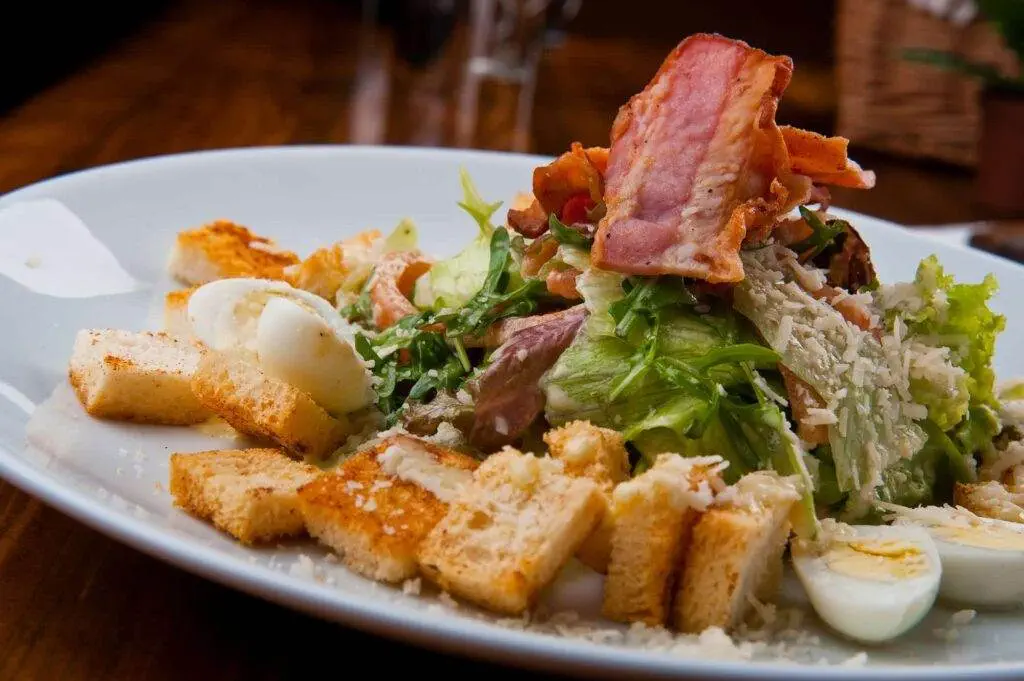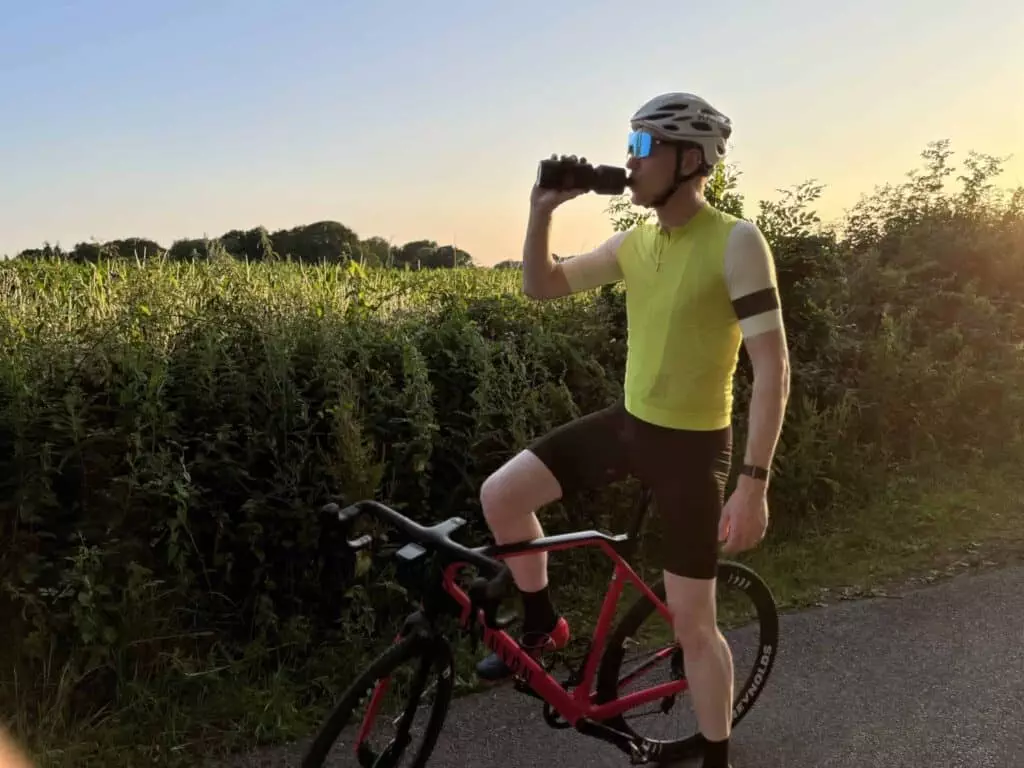What you eat while training for endurance rides and actually out on the bike on long distance rides is vital for your performance.
Diet is often overlooked when it comes to sports training, but cyclists require enough fuel and hydration to feel their best during training and long distance events.
Our guide will help you with the ins and outs of sports nutrition so that you can go on long rides without struggling for energy or feeling sluggish from eating too much.
Key Takeaways: What to Eat When Cycling Long Distance
- Carbs are important for glycogen, which gives you energy.
- Proteins are the building blocks of your muscles and consuming protein helps with recovery.
- Fats are essential to help you absorb vitamins and minerals.
- Always make sure you are properly hydrated during your ride.
- Snacking on bananas, nuts, and energy bars while pedaling will ensure you have sustained energy.
1: Carbohydrates
You’ve probably heard of the term “carbs” or “carbo-loading”. Well, this refers to the carbohydrates found in many foods.
The mitochondria in your cell use carbs – a simple sugar – to produce energy. Carbohydrates are converted to glucose. If the body does not burn all the glucose, it is converted to glycogen.
The glycogen is then stored in your muscles, blood, and liver as energy stores, which you can tap into when cycling long distances.
As soon as you hit the pedals, you’ll begin burning the glycogen, which must be replenished frequently. That is why you must eat carbs before and during your long ride.
Just don’t overdo it on the carbohydrates! There is only a certain amount your body can absorb per hour – around 2.12 oz (60 g).
It is best to opt for low-glycemic carbs. These burn slower and will not give you that sugar high. Instead, you’ll have a sustained source of energy.
Carbs can be ingested as part of your breakfast or pre-race meal, or you can have them as snacks during the ride.
Examples of good carbohydrates
- Potatoes
- Vegetables like broccoli or peas
- Beans
- Nuts
- Grains (rice, pasta, quinoa, rice)
- High fiber bread
- Energy gels, dates, or bananas during the ride

2: Protein
It should come as no surprise that protein is super important when it comes to endurance cycling.
Our muscles are made up of proteins, as are a lot of the connective tissues in our body.
Protein repairs injured muscles and fibers, helping with muscle soreness and recovery. Protein also increases your glycogen storage (which we just discussed), meaning you can store more sustained energy.
You’ll need about 0.04 to 0.05 oz of protein per kilogram of your body weight, every day. It increases your stamina for long distance cycling and prevents those stiff muscles the next day.
Examples of good protein
- Lean meat (chicken, turkey)
- Beans and legumes
- Eggs (specifically egg-white)
- Tofu
- Yogurt
- Low-fat dairy
- Peanut butter (and other nut butter)
3: Fats
Fats usually don’t get the attention and love they deserve. And no, we don’t mean munching down on an oily fast food meal.
There are many healthy fats out there that are able to help you better perform on long distance bike rides.
There are three types of fats: saturated, unsaturated, and trans. Unsaturated fats, like omega 3 and 6, are the healthiest option as they do not cause stomach upset (something you want to avoid at all costs when cycling long distances!).
Fats provide energy slowly but only tend to be used once the glycogen has been depleted.
Examples of good fats
- Olive oil
- Flaxseed oil
- Avocado
- Nuts and seeds
- Fish (salmon or tuna)

4: Hydration
Cycling long distance is hard work, which is why you need to keep on top of your hydration.
Not only do you lose electrolytes and water through sweat, but you also lose sodium and sugar.
To make sure you’re properly hydrated, you should mix water with electrolytes to replace what you are losing. High-carb drinks like energy drinks can also help to keep you hydrated.
Exactly how much hydration you would need depends on your body, the distance you are cycling, and the weather conditions. But, as a general rule of thumb, try to consume one bottle of water or sports drinks every hour.
If you prefer to cycle with only some fresh water, consume some snacks or a proven energy food (like a high-fiber sandwich with peanut butter) to ensure you are still getting enough energy.

5: Snacks
It’s not just about eating the day before a long distance cycling event – you also need to be fueled while on the bike!
Snacks and sports drinks are very helpful in providing you with energy throughout the day. Snacks like energy bars and gels are specifically formulated to help you have a consistent energy supply for long bike rides.
Plan your snacks ahead of time so that you have enough carbs and protein to eat during (and directly after) the ride.
Examples of good snacks
- Bananas
- Nuts (specifically pistachios)
- Dates
- Protein bar
- Energy bar
- Energy gel
- Sports drinks
6: Pre-Ride Nutrition
We have mentioned how important it is to snack while you ride, but your body will also have to build up energy stores before you hit the tarmac.
You need to have enough glycogen to provide you with energy for the duration of the ride. Luckily, it’s pretty easy to achieve!
All you need to do is make sure you eat regular healthy meals for the days leading up to your distance ride and especially pay attention to the food you consume a few hours before you head out.
A couple of days before your ride or cycling event you can ingest complex carbs (like pasta). These take longer to digest but will provide you with energy in the long run. This is what experts consider to be carbo-loading.
Foods high in fiber can be eaten closer to your cycling session (a few hours before) – fruits and vegetables are especially good to eat about 4 hours before you begin pedaling.
Make sure to eat a good breakfast filled with high-energy foods on the morning of your ride. High-glycemic carbs, like cereals, toast, or croissants will provide you with long-lasting energy.
But just take note – the days leading up to, and the day of, your cycling event is not the time to try out new brands and new snacks. The last thing you’d want is to have to take regular bathroom breaks or deal with stomach cramps while out on the road.
Next Steps: Sample Meal Plan
We know that was a lot of information to take in, and you might still be left with the question: “Exactly WHAT am I meant to eat, though?“
To help guide you, we’ve compiled a sample meal plan to help you decide what to eat.
Note that these are just guidelines and you should speak to a dietician or sports nutritionist if you have any specific concerns.
Pre-ride meals
These options will help you build up your body’s glycogen stores to provide you with sustained energy once you start pedaling.
Breakfast Options
- Oatmeal with honey and a banana; you can mix nuts and seeds into the oatmeal
- Three pancakes with honey, peanut butter, and fresh strawberries
- Wholewheat toast (two slices), with an egg, banana, and fresh fruit juice
- Protein shake
Lunch and dinner Options
- Chicken, rice, and vegetables
- Turkey burger with grilled vegetables
- Wholewheat spaghetti and meatballs
- Smoked salmon and rice
- Grilled chicken wrap with hummus
During the ride
Snacks during the ride will ensure you have enough energy to keep you going.
- A bottle of hydration mix
- Energy bars
- Peanut butter and jelly sandwich
- Banana
- Pistachios
- Energy gels
- Sports drinks or water
Post-ride meals
You want to eat a balanced meal after cycling to help prevent muscle pain and replenish your glycogen stores.
- Eggs with wholegrain toast
- Grilled chicken and pasta
- Tuna and rice
- Tofu with green vegetables
- Avocado on toast
- Protein shakes
FAQs
How many calories do you burn when cycling long distances?
It depends on you and your body, but on average, a cyclist can burn between 2,000 to 7,000 calories while doing a long ride. During an hour of moderate cycling, a male cyclist burns around 600 calories, and a female 500 calories. For this reason, it is important that you consume enough carbs to fuel you.
Are solid foods, gels or drink mixes best for a long ride?
It really comes down to your own preference. However, some cyclists struggle with solid foods causing gastrointestinal issues while cycling, which is why they prefer gels and sports drinks.
